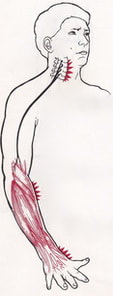The Cervical Spine

Loss of neuromusculoskeletal equilibrium at the cervical spine begins a pernicious degenerative process progressing from micro to macro lesion of the soft articular tissues (ligaments, cartilage and discs) associated with eventual local pain of the lesion itself and chronic irritation of the contiguous nerve tissue (dural sac, spinal cord, and spinal nerves roots) with the possibility of symptoms local or distant to the central irritation. The most common sensory symptoms caused by chronic irritation of the nerve tissues are: headaches, temper-mandibular pain, tinnitus, vestibular disorders, disorders of the digestive system, sore neck, pain in the upper back, shoulder pain, arm pain, elbow pain, wrist pain, carpal tunnel and hand pain. The common motor problem is the loss of instantious muscle coordination with eventual muscle weakness and decreased joint stability. Proper management in the clinic, at home, at work and at play allows recovery normal locomotor equilibrium to dis-inflame the chronically irritated tissues and the lesioned soft articular tissues to heal. As healing progresses the symptoms diminish and then eventually disappear.
The mechanisms of suffering
Below left are a series of cervical MRI's in profile of typical patients who seek care. They demonstrate visually the relationship between chronic degenerative process at the cervical spine and contiguous nerve tissue when there is a loss of locomotor equilibrium. Initially symptoms are caused by irritation only. It is the equivalent to having a neurological "pebble in your shoe". Each movement can irritate. This chronic irritation causes motor and sensory dysfunction with eventual spontaneous problems anywhere within the locomotor system. But as you can see in the final MRI images over time the degenerative damage can become quite serious.
Below left are a series of cervical MRI's in profile of typical patients who seek care. They demonstrate visually the relationship between chronic degenerative process at the cervical spine and contiguous nerve tissue when there is a loss of locomotor equilibrium. Initially symptoms are caused by irritation only. It is the equivalent to having a neurological "pebble in your shoe". Each movement can irritate. This chronic irritation causes motor and sensory dysfunction with eventual spontaneous problems anywhere within the locomotor system. But as you can see in the final MRI images over time the degenerative damage can become quite serious.
The continuous daily movement of head and neck in state of pathological disequilibrium slowly destroys the soft articular tissues of the cervical spine. Arthrosis, discopathy, disc bulge, bulging disc, herniated disc (arthropathy) with irritation associated with nerve tissue (neuropathy) and the formation of trigger points are consequences of the loss of locomotor equilibrium in progress.
The symptoms and the resulting irritation can be dramatic and intolerable near or distant to the lesion. Think of it as a river. There is upstream and downstream. If there is a blockage upstream, it makes a change downstream. In the same way - if there is a problem that involves the nerve tissue upstream, you feel it downstream. A common area that this happens is with the nerves that supply the arm. The brachial plexus is the nerve bundle, vein and artery supplying the arm. If its function is hindered in any way upstream (for example, a tight muscle with hidden trigger points presses on it, or lack of locomotor equilibrium at the cervical spine), then you will suffer downstream.
Chronic poor posture, an old neglected neck injury, or hidden trigger points in the neck and chest can cause pain in the head or neck, but also your shoulder, arm, elbow, wrist or hand. Common symptoms are numbness, swelling, pain and other unpleasant sensations in the arm and hand. And if you were to treat locally only the arm or the hand itself, you would completely miss the primary cause of symptoms.
Chronic poor posture, an old neglected neck injury, or hidden trigger points in the neck and chest can cause pain in the head or neck, but also your shoulder, arm, elbow, wrist or hand. Common symptoms are numbness, swelling, pain and other unpleasant sensations in the arm and hand. And if you were to treat locally only the arm or the hand itself, you would completely miss the primary cause of symptoms.
